Birds of mystery and grace, American Golden-Plovers are also athletes beyond comprehension. Standing on the granite shore of a spruce-cloaked Maine coastal headland on a crisp October day, and hearing the plaintive “queedle” call of this species, faintly from high overhead, evokes in us, a sense of connection to something elemental. That something is the natural rhythm of life, the shift in seasons that brings cold to the north in fall and signals the start of migration to warmer places farther south for billions of birds.
American Golden-Plovers survive on this Earth by making a roundtrip journey from the Southern Cone of South America, where they winter, to the Arctic and Boreal, where they nest. Some that nest in the North Slope of Alaska will depart in August and fly 2,000 or more miles to Newfoundland, the Maritimes, or New England. From here they will depart for a multi-day and night non-stop flight of 2,000 to 3,000 more miles over the open Atlantic Ocean to reach the South American continent. It is yet another 3,500 miles for them to reach the grasslands and wetlands of southern South America, where they will ultimately spend the winter months. Few birds on our planet make a longer migratory journey.
In spring these same birds will head north across South America but will take a more westerly route through Central America and Mexico, and through the grasslands of the Central U.S. and Canada before fanning out to their breeding grounds that stretch from the Hudson Bay Lowlands of Manitoba west to Alaska.
Before the 1800s, numbers of these birds were vastly greater, perhaps in the millions. But they were harvested relentlessly during spring and fall migration during that century, sometimes in the thousands in a single locale. Here in Maine, a single hunter recorded shooting more than 700 in Scarborough from 1842-1854. The populations must have also suffered from conversion of much of the native grasslands that they used in spring migration in the central U.S. to agriculture.
Even today, our knowledge of the status of these far-flying birds is vastly incomplete. There is a general consensus that numbers are declining, but data are hard to obtain for a species that nests in remote Arctic and Boreal regions and passes quickly through areas to the south during migration. According to the book Birds of Maine, the highest counts of American Golden-Plover known from modern times were of 150 in September, 1967, and 160 in October, 1970, from the hayfields that once occupied the site of today’s Bangor Mall. Most birders today are happy to see a handful during fall migration.
A new project called Tullik's Odyssey was designed to learn more about the specifics of migration of American Golden-Plovers and to share the remarkable journey with as many people as possible. In June of this year, eight of the birds were fitted with the smallest and most up-to-date satellite transmitters, at Teshekpuk Lake Special Use Area within the National Petroleum Reserve-Alaska. The Tullik’s Odyssey website https://www.tulliksodyssey.org/ is already stocked with a series of interesting interview blogs about the birds, the places, and the people involved in the project. Soon the birds will begin their southward movements from Alaska, and there will be regular updates of their positions throughout their journeys.
We can’t wait to see if some pass over or through Maine, and where they go from here. How long will they linger over on the Atlantic Coast before departing for the long overwater flight? Will any hurricanes block their way south over the Atlantic this fall, as sometimes happens? How will they cope? Will some stop off in the Caribbean or the southern U.S.? We hope you will check in regularly through the fall to Tullik’s Odyssey to find the answers to these and many more questions!
Jeffrey V. Wells, Ph.D., is a Fellow of the Cornell Lab of Ornithology and Vice President of Boreal Conservation for National Audubon. Dr. Wells is one of the nation's leading bird experts and conservation biologists. He is a coauthor of the seminal “Birds of Maine” book and author of the “Birder’s Conservation Handbook.” His grandfather, the late John Chase, was a columnist for the Boothbay Register for many years. Allison Childs Wells, formerly of the Cornell Lab of Ornithology, is a senior director at the Natural Resources Council of Maine, a nonprofit membership organization working statewide to protect the nature of Maine. Both are widely published natural history writers and are the authors of the popular books, “Maine’s Favorite Birds” (Tilbury House) and “Birds of Aruba, Bonaire, and Curaçao: A Site and Field Guide,” (Cornell University Press).


-Peter Wilton-Churchill.jpg)


























